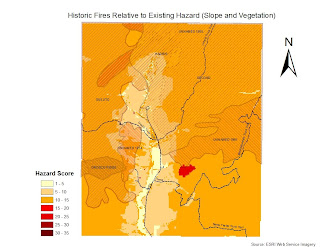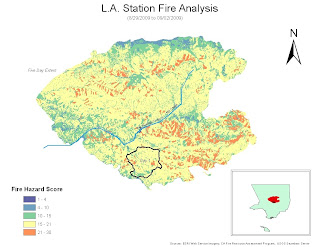I. IntroductionLos Angeles County is notorious for its poor air quality. Historically, its air quality has been attributed to Los Angeles County’s heavy reliance on personal cars and lack of an expedient public transit system. Although this is true-- air quality monitors record increases in pollutant levels during commute times—a significant amount of pollutants stem from point sources through utility, commercial, and industrial processes. This research project will focus on whether low income populations are disproportionately exposed to pollutants from point sources in LA County.
My objective is to determine if point source emissions had a higher propensity to be situated near low income populations than high income populations—and if so, to what degree.
Carbon monoxide (CO), nitrogen oxides (NOx), and fine particulate matter (PM2.5) were chosen as the three pollutants to be analyzed. All three are regulated by the Clean Air Act. Of these pollutants, Los Angeles only exceeded national levels for PM2.5.
Carbon MonoxideCarbon monoxide was chosen because approximately 70% of CO emissions in LA County stem from vehicular traffic. The top non-vehicle CO sources are fossil fuel combustion, industrial processes, and non-road equipment. CO was selected because I thought that since CO emissions fell within federally regulated limits, it might be easier for CO intensive facilities to infiltrate low-income communities. Prolonged carbon monoxide exposure can cause adverse health effects such as chest pain chest pain and can exacerbate existing conditions.
Nitrogen Oxides In Los Angeles County, approximately two-thirds of nitrogen oxide emissions stem from sources other than vehicular traffic. Similar to carbon monoxide, the top non-vehicle CO sources are fossil fuel combustion, industrial processes, and non-road equipment.
Nitrogen oxides can result in inflamed airways and additional side effects in asthmatics. Nitrogen oxides can also increase the formation of smog.
Fine Particulate Matter (PM2.5)PM2.5 is unique from the other two pollutants in a couple of ways. First, PM2.5 is the only pollutant of the three analyzed to be nonattainment. Second, industrial processes and nonroad equipment far exceed the amount generated by on road vehicles. Third, fine particulate matter has the most adverse side effects. Studies show that it can lead to decreased lung function, aggravated asthma, irregular heartbeat, chronic bronchitis, and nonfatal heart attacks.
II. MethodsData was collected from four sources:
1. The UCLA GIS Database (http://gis.ats.ucla.edu/)
2. The US Census Bureau’s Fact Finder (http://factfinder2.census.gov/faces/nav/jsf/pages/searchresults.xhtml?ref=geo&refresh=t#none)
3. The US Census Bureau’s TIGERLINE Project (http://arcdata.esri.com/data/tiger2000/tiger_download.cfm)
4. The EPA National Ambient Air Quality Standard Database(http://www.epa.gov/air/data/geosel.html)
Point Source DataPoint source data was obtained from the US EPA Air Quality System. The data provided was an address, name of facility, industry, and the amount of emissions. 2002 emissions data was used because it was the most current data. Point sources were used rather than air monitoring stations because there was much more data on point sources.
GeocodingThe top 100 point sources for each pollutant were copied into an excel spreadsheet. Some of the addresses needed additional formatting to make it suitable for the ArcEditor ‘Geocode Addresses’ tool. Additional zip code or more specific street information was retrieved from Google Maps. Further formatting was primarily achieved through the ‘RIGHT’ and ‘LEFT’ excel functions. One spreadsheet was created for each pollutant. Each spreadsheet was imported and geocoded using an address locator based on LA County streets data that was downloaded from the UCLA GIS database.
Spatial JoinThe US Census Bureau income data was in the form of an excel spreadsheet. Therefore, the ArcMap ‘spatial join’ tool was used to add the income data to the TIGERLINE county shapefile. The TIGERLINE shapefile the spatial join could only be done on a census tract level rather than the smaller census block level because the nomenclature for census blocks varied between the income and county data.
Graduated QuantitiesMedian income was displayed with graduated quantities. The first break, $22050, was chosen because it was the poverty line for a family of four. The second break, $33075, is one and a half times the poverty line. The third break, $55452, was the average income in Los Angeles. The fourth, $201000, is the maximum amount recorded by the Census Bureau.
Select by LocationAfter point source emissions and median income was displayed, I used the ‘select by location’. Areas identified within the proximity of a point source were selected. The data table with selected values was then exported and opened in excel. Using excel functions, I performed a statistical analysis of the income data. This process was repeated for the top 50 point sources for each pollutant.
III. ResultsFor each pollutant, the figure on the left graphically displays the 100 highest-emitting point sources (excluding airfields) relative to census tract median income. In each of these maps, any area that exceeded the national average is displayed in the lightest color. The figure on the right shows a selected area of census tracts within 1 mile of the top 50 point sources within LA County.
Carbon Monoxide(CO) Nitrogen Oxides (NOx)
Nitrogen Oxides (NOx) Fine Particulate Matter (PM2.5)
Fine Particulate Matter (PM2.5) Summary Table
Summary Table IV. Conclusion
IV. ConclusionBased on my data, lower income areas were typically closer to air pollution point sources than higher income areas. My analysis suggests that point sources can be generally associated with areas with incomes below the county average. Census tracts that contained point sources had incomes between $4000 and $7000 below the average Los Angeles County income. Peculiarly, the census tracts within 1 mile of the larger pollutant sources had higher mean incomes than the smaller sources. For PM2.5 and NOx, incomes of these census tracts actually exceeded the county average. This suggests that large plants may benefit the local community by providing high-paying manufacturing and blue collar jobs. In contrast, low intensity point sources seem to have a negative correlation with income. No significant differences were seen between PM2.5 relative to CO and NOx. While people with higher incomes would likely select away from low air quality areas, the magnitude of this effect was not captured. Outside a one mile radius, the mean incomes were slightly higher than the county average. The maps also capture many regions that have a high density of pollutant sources—likely related to industrial and manufacturing centers.
GIS was instrumental in the analysis because it tied together non-spatial data (income) with spatial data (point sources). It also helped visually identify key regions that have a higher density of point source emissions. While this analysis solely focused on just three pollutants, further research could be extrapolated to many others.
Sources:
1. http://quickfacts.census.gov/qfd/states/00000.html
2. http://liheap.ncat.org/profiles/povertytables/FY2010/popstate.htm
3. http://www.epa.gov/air/data
4. http://factfinder2.census.gov/faces/nav/jsf/pages/searchresults.xhtml?ref=geo&refresh=t#none
5. http://gis.ats.ucla.edu/










